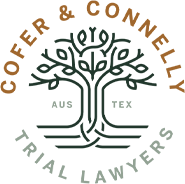On October 25, 2021, Governor Greg Abbott signed into law a bill that animal advocates everywhere applaud and celebrate. Unlawful Restraint of Dogs is now a crime punishable in the State of Texas. Lady Bird, one of Cofer & Connelly's lovable four-legged mascots is thrilled!

After the statute passed during the Legislature’s third special session of 2021, this pro-animal rights bill is set to go into effect just a few weeks after the new year on January 18, 2022. Owners who knowingly leave their dogs outside and unattended are now mandated by law to provide their dogs with appropriate shelter, space, and access to drinkable water and shade from the sun. Additionally, owners are no longer permitted to use chains or weights to restrain their dogs, and instead must tether their dogs outside as outlined by the new bill.
For help understanding dog restraint law in Texas, contact Cofer & Connelly, PLLC today.
Dog Restraint Law in Texas
The offense is now codified as Texas Health & Safety Code, Subchapter E, Section 821.102 – Unlawful Restraint of Dog. According to this law:
An owner may not leave a dog outside and unattended by use of a restraint unless the owner provides the dog access to:
- Adequate shelter
- An area that allows the dog to avoid standing water and exposure to excessive animal waste; (3) shade from direct sunlight
- Potable water
In addition, Section 821.102 further states that an owner may not restrain a dog outside and unattended by use of a restraint that: (1) is a chain; (2) has weights attached; (3) is shorter in length than the greater of either five times the length of the dog, or 10 feet; or (4) is attached to a collar or harness not properly fitted.
.2201171433550.jpg)
The Penalties for Unlawful Restraint of Dogs Violations
An offense under Section 821.102 is a Class C misdemeanor. However, if a person has already been previously convicted under this section, a further offense becomes a Class B misdemeanor. An offense under Section 821.102 is committed if the person knowingly violates this section, and the unlawful restraint of each dog in violation of this section is a separate offense. A person whose conduct constitutes a violation under this section and a violation of any other law, may be prosecuted under either section of law, or both.
Defining the Finer Points of the New Law
Section 821.101 provides a list of key definitions relevant to the new law. An owner refers to a person who “owns or has custody or control” of a dog. Adequate shelter is defined as a ‘sturdy structure’ which can protect the dog from inclement weather such as ‘rain, hail, sleet, snow, high winds, extremely low temperatures, or extremely high temperatures,’ and is big enough to allow the dog to ‘stand erect, sit, turn around, and lie down in a normal position.’ Restraint means ‘a chain, rope, tether, leash, cable, or other device that attaches a dog to a stationary object or trolley system.’ The term ‘collar’ is broadly defined as “a band of material specifically designed to be placed around the neck of a dog,” while the term “harness” refers to ‘a set of straps constructed of nylon, leather, or similar material, specifically designed to restrain or control a dog.’
Understanding the Definition of a “Properly Fitted” Collar
With respect to a collar or harness as defined under Section 821.101, ‘properly fitted’ refers to a collar or harness that:
- is appropriately sized based on the dog’s measurements and body weight;
- does not choke the dog or impede normal breathing or swallowing; and
- does not cause pain or injury to the dog. During the early discussions surrounding this new bill, some rural legislators expressed concern over its potential negative impact in the restraint and use of guard dogs or animals in ranches or other agricultural work.
Exceptions to the Unlawful Restraint of Dog Offense
In response, Section 821.103 was included and provides several exceptions to the Unlawful Restraint of Dog offense. Section 821.103 states that Section 821.102 does not apply to:
- the use of a restraint on a dog in a public camping or recreational area in compliance with the requirements of the relevant federal, state, or local authority or jurisdiction;
- the use of a restraint on a dog while the owner and dog engage in, or actively train for, an activity conducted under a valid license issued by this state provided the activity is associated with the use or presence of a dog;
- the use of a restraint on a dog while the owner and dog engage in conduct directly related to the business of shepherding or herding cattle or livestock;
- the use of a restraint on a dog while the owner and dog engage in conduct directly related to the business of cultivating agricultural products;
- a dog is left unattended in an open-air truck bed only for the time reasonably necessary for the owner to complete a temporary task that requires the dog to be left unattended in the truck bed;
- a dog taken by the owner, or another person with the owner’s permission, from the owner’s residence or property and restrained by the owner or the person for not longer than the time necessary for the owner to engage in an activity that requires the dog to be temporarily restrained; or
- a dog restrained while the owner and dog are engaged in, or actively training for, hunting or field trialing.
The restraint length requirement of Section 821.102 does not apply to a restraint attached to a trolley system that allows the dog to move along a running line for a distance equal to or greater than the lengths specified under that subsection. This new subchapter will not prohibit a person from walking a dog with a handheld leash.
In addition, Section 821.104 states this subchapter does not preempt a local regulation that relates to the restraint of a dog or affect the authority of a political subdivision to adopt or enforce an ordinance or requirement relating to the restraint of a dog if the regulation, ordinance, or requirement: (1) is compatible with an equal to or more stringent than a requirement prescribed by this subchapter; or (2) relates to an issue not specifically addressed by this subchapter.
.2201171433550.jpg)
Get In Touch with Our Firm
The law goes into effect on January 18, 2022, and represents a compromise between protecting the rights and integrity of man’s best friend, and understanding the different roles and jobs that dogs have in rural communities.
Call (512) 991-0576 today to contact our attorneys at Cofer & Connelly, PLLC.

